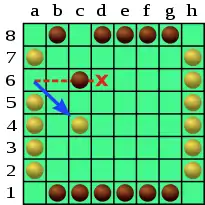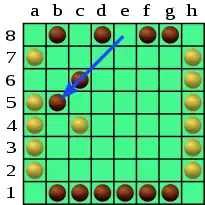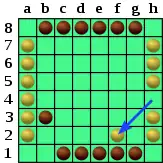Lines of Action
Lines of Action (or LOA) is an abstract strategy board game for two players invented by Claude Soucie. The objective is to connect all of one's pieces into a single group.
 Lines of Action starting position | |
| Designer(s) | Claude Soucie |
|---|---|
| Genre(s) | Board game Abstract strategy game |
| Players | 2 |
| Setup time | < 1 minute |
| Random chance | None |
| Skill(s) required | Strategy, tactics |
| Synonym(s) | LOA |
The game was recommended by the Spiel des Jahres in 1988.[1]
Rules
Goal
The object of the game is to bring all of one's checkers together into a contiguous body so that they are connected vertically, horizontally or diagonally (8-connectivity).
Movement summary
- Players alternate moves, with Black having the first move.
- Checkers move horizontally, vertically, or diagonally.
- A checker moves exactly as many spaces as there are checkers (both friendly and enemy) on the line in which it is moving. For example, Black may open with c8-c6. Black's checker moves two
Movement diagrams
A checker may not jump over an enemy checker. Thus in the diagram below, White cannot play a6-d6, even though there are three checkers in row 6. White might instead play a6-c4, moving two spaces because there are two checkers in the diagonal (a6-f1) in which White is moving.

A checker may jump over friendly checkers. Thus Black may continue with e8-b5, jumping his own checker. He moves three spaces because there are three checkers in the diagonal (a4-e8) in which he is moving.

A checker may land on a square occupied by an enemy checker, resulting in the latter's capture and removal from the game. For example, White may play h3-f1, capturing the black checker on f1.

A player who is reduced to a single checker wins the game, because his pieces are by definition united. If a move results, due to a capture, in each player having all his pieces in a contiguous body, then either the player moving wins, or the game is a draw, depending on the rules in force at the particular tournament.
Simultaneous connection
In the original 1969 edition of A Gamut of Games, simultaneous connection was described as a draw. In the second edition, the rules were changed to declare this a win for the player moving. Here is Sid Sackson's note in the preface to the second edition: "Claude Soucie and I are all that remains of N.Y.G.A. At his request, I have corrected an error in the rules for LINES OF ACTION, eliminating possible draws." However, despite the intention of the inventor of LOA, most present day tournaments including the World Championships at the Mind Sports Olympiad score simultaneous connection as a draw.
Strategy
The game can become quite tactical in open positions where the checkers on both sides are mobile. The strategic depth of the game, however, derives to a large extent from blocking strategies designed to limit the opponent's mobility. It can be advantageous to pin one or more enemy checkers against the side of board by moving in the second row or column.
Having more checkers is usually an advantage, because they can limit the opponent's options as they mass together. On the other hand, material considerations are not all-important, because having fewer checkers also means having fewer to unite.
Example game
The above moves illustrated the rules, but not necessarily good play. The following moves are more typical of expert play.

Black plays b1-b3. The checker moves two squares vertically, because there are two checkers in the file: b1 and b8. This move gives White no opportunity to capture, and threatens to hem in the pieces on the a-file.

White moves h4-f2. The checker moves two spaces because there are two checkers in the diagonal: h4 and e1. White threatens the mobility of Black's checkers in the bottom row.

Black plays d1:a4, jumping over his own checker (which is permitted) and capturing the white checker at a4. Note that Black moved three spaces, as there were three checkers in the diagonal: a4, b3, and d1.
It isn't clear whether the capture is advantageous or not. Black does now have an extra checker, but the move didn't do much to block White or build a central mass for Black. Usually early captures on the edge are not especially powerful, whereas early captures in the center are extremely good.

White plays h2-e2, continuing the blockade of the first rank. The checker moves three squares, jumping over a friendly checker. White, despite the substantial disadvantage of moving second, apparently is in the lead now due to the reduced mobility of Black's first-row checkers. White will soon play a2-d2, continuing to build his own bridge and forcing Black's checker on e1 to move sideways if it wants to join the game. It hardly helps for Black to try to escape with e1-c3, because that allows White to capture with a5:c3.
Example winning move
In the diagram below, White has made a move that connects all his pieces while Black is still at least two moves from such a state. Thus, White has won the game.

Champions
The World Championships take place annually at the Mind Sports Olympiad. World champions from 1997 onwards are given in the list below.[2]
- 1997:
 Fred Kok
Fred Kok - 1998:
 Hartmut Thordsen
Hartmut Thordsen - 1999:
 Fred Kok
Fred Kok - 2000:
 Jochen Drechsler
Jochen Drechsler - 2001:
 Koichi Nicholas
Koichi Nicholas - 2002:
 Fred Kok
Fred Kok - 2003:
 Koichi Nicholas
Koichi Nicholas - 2004:
 Fred Kok
Fred Kok - 2005:
 Koichi Nicholas
Koichi Nicholas - 2006:
 Fred Kok
Fred Kok - 2007:
 Tim Hebbes
Tim Hebbes - 2008:
 James Heppell
James Heppell - 2009:
 Tim Hebbes
Tim Hebbes - 2010:
 Andres Kuusk
Andres Kuusk - 2011:
 Tim Hebbes
Tim Hebbes - 2012:
 Peter Horlock
Peter Horlock - 2013:
 Ankush Khandelwal
Ankush Khandelwal - 2014:
 Alain Dekker
Alain Dekker - 2015:
 Andres Kuusk
Andres Kuusk - 2016:
 James Heppell
James Heppell - 2017:
 James Heppell[3]
James Heppell[3] - 2018:
 Andres Kuusk[4]
Andres Kuusk[4] - 2019:
 James Heppell[5]
James Heppell[5] - 2020:
 James Heppell[6]
James Heppell[6]
Variant
A variant of Lines of Action with a different starting position was also proposed by Soucie and is known as Scrambled Eggs.[7]
References
- LoA on German Spiel des Jahres official website
- Mind Sports Olympiad LOA Results http://www.boardability.com/result.php?id=lines_of_action 10 July 2010
- 2017 MSO medal table https://msoworld.com/2017-medal-table/ 18 Jan 2021
- 2018 MSO medal table https://msoworld.com/2018-medal-table/ 18 Jan 2021
- 2019 MSO medal table https://msoworld.com/2019-medal-table/ 18 Jan 2021
- 2020 MSO medal table https://msoworld.com/2020-medal-table/ 18 Jan 2021
- http://brainking.com/en/GameRules?tp=86 Brain King Web page: Scrambled Eggs Rules
Bibliography
- Sackson, Sid (1982) [1st Pub. 1969, Random House, New York]. A Gamut of Games. Pantheon Books. ISBN 0-394-71115-7.
- Schmittberger, R. Wayne (1992). New Rules for Classic Games. John Wiley & Sons Inc. ISBN 978-0471536215.